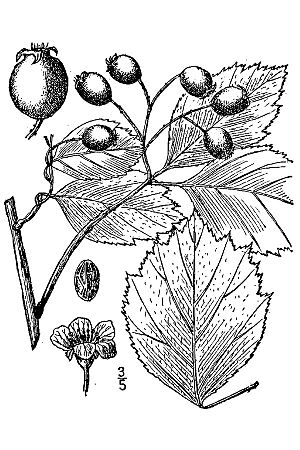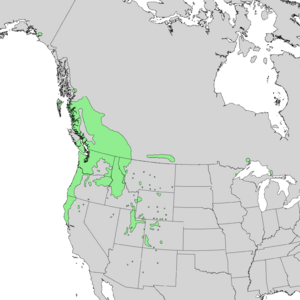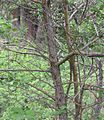Black hawthorn facts for kids
Quick facts for kids Crataegus douglasii |
|
|---|---|
 |
|
| Scientific classification | |
| Kingdom: | |
| (unranked): | |
| (unranked): | |
| (unranked): | |
| Order: | |
| Family: | |
| Genus: | |
| Section: |
Douglasia
|
| Series: |
Douglasianae
(Loudon) Eggl. ex Rehder
|
| Species: |
C. douglasii
|
| Binomial name | |
| Crataegus douglasii |
|
 |
|
| Natural range of Crataegus douglasii | |
| Synonyms | |
Crataegus douglasii is a type of hawthorn plant that grows in North America. People often call it the black hawthorn or Douglas' thornapple. It got its name from David Douglas, a botanist who collected seeds from this plant a long time ago.
This plant is a shrub with thorns. It grows naturally in northern and western North America. You can find it in many places, from forests to open scrublands. It is most common in the Pacific Northwest region.
Contents
What Does Black Hawthorn Look Like?
The black hawthorn is a compact, bushy shrub. It has green leaves shaped like a fan. The edges of the leaves have small teeth.
Its branches have thorns that are about one to two centimeters long. These thorns help protect the plant.
Flowers and Fruit
White flowers with greenish centers grow in bunches. You can see these flowers at the ends of the thin branches.
After the flowers, the plant grows dark purple fruits. These fruits are called pomes and are about one centimeter wide. Native American groups, like the Cheyenne and Nlaka'pamux peoples, used to eat these fruits. They were a good source of food.
Who Eats Black Hawthorn?
Many animals use the black hawthorn for food. Cattle and sheep eat the leaves. Various birds, like quail, Hungarian partridges, and ring-necked pheasants, enjoy eating the berries.
Home for Butterflies
The black hawthorn is also a special home for certain butterflies. It is a "larval host" plant. This means that butterfly larvae, which are caterpillars, eat its leaves.
Some of the butterflies that use black hawthorn as a host plant include the gray hairstreak, mourning cloak, pale tiger swallowtail, and western tiger swallowtail.
Images for kids









